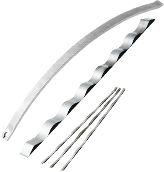- keyword
- formula
- torsion angle
- torsional moment
Question 高橋 2005/4/25(Mon) 18:08
It may be a little off from the spring’s topics, but I did not when deriving the design formula of the spring, so I decided to post my question.
When I studied the polar moment of inertia Ip of a rectangular cross section, the term Saint-Venant’s torsion constant J comes out. I was confused about how to use it and I didn’t really understand it. So here is the first question.
① Do you call the polar moment of inertia Ip of the rectangular cross section the torsion constant J of Saint-Venant? I would like to know the value of the polar moment of inertia Ip of the rectangular cross section while generally Ip = Ix + Iy.
② Is the following correct: if it is axb section, Ip = (ab(a^2+b^2)/12.
Answer Tokai Spring 2005/4/29(Fri) 14:07
① In the case of a rotationally symmetrical cross section, the polar moment of area (Ip) is the torsional resistance coefficient of the elements and is calculated by Ip=∫r^2・dA=Ix+Iy.
If the torsion angle (θ) is generated by the torsion moment (Mt), the torsion angle can be calculated by θ=Mt/(G·Ip).
At this time, (G·Ip) is a constant called thetorsional stiffness or torsional rigidity.
However, (G) is the shear modulus of elasticity.
Therefore, I think the Saint-Venant’s torsional constant is probably this “torsional rigidity”. What do you think about this?
② In case of rectangular cross section (axb), Ip=Ix+Iy=(a^3・b/12)+(a・b^3/12),
so Ip=(ab(a^2+b^2))/ 12
We are happy to answer any inquiries regarding technology, specifications, materials, etc. Please feel free to ask.

















